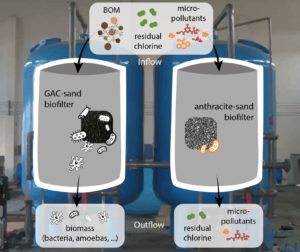The removal of biodegradable organic matter (BOM) from drinking water treatment plan effluents is a key issue in water treatment technology. BOM consists of oxygenated compounds such as carbohydrates, small carbonyls and carboxylic acids that are mainly produced during ozonation, a treatment performed to decrease the organic carbon content of the inflow. Biodegradable organic matter is an excellent carbon source and can foster microbial growth within the distribution system, leading to a decrease in the microbiological water quality.
Biofilters can help solving this problem. Different from conventional filters, biofilters are composed of an inert material, either anthracite, sand or granular activated carbon (GAC), which microorganisms can grow on. Common types include the GAC-sand and the anthracite-sand biofilters. As a general strategy, the raw water is first ozonated, leading to a decrease of organic carbon, but an increase in BOM. Then the BOM-rich water is circulated through the biofilter, where BOM is used as a substrate for microbial growth1.
Biofilters are in every respect “living organisms”, whose activity and effectiveness can change over time. Thus, a systematic evaluation of risks and benefits is of primary importance. Following the detection of free-living amoebas in GAC-sand filter effluents, de Vera et al. set a study with the aim of investigating the effect of biofilter media on the microbiological quality of the effluent and on the microbial community of the biofilters. Amoebas have not been thoroughly studied in drinking water biofilters, and also include pathogenic species that have recently been listed in the U.S. Environmental Protection Agency’s Contaminant Candidate List.
De Vera et al. collected water samples from an operating drinking water treatment plan that was equipped with both GAC-sand and anthracite-sand biofilters. They measured turbidity, particle counts and ATP counts in the effluent, concluding that the anthracite-sand biofilter was more effective in preventing biomass release – thus, the microbiological quality of the effluent was higher. According to the authors, this effect was due to the ability of the GAC-sand biofilters to quench residual chlorine, which was present in the biofilter influent. This allowed greater biomass development and biofilter activity, but also increased the release of microorganisms in the effluent.

Using molecular biology techniques, the authors analyzed the microbial community structure of the two filter types. Their results showed that substantially different bacterial and invertebrate communities are present in the two biofilters, with the GAC-sand filters hosting a richer and more diverse bacterial community. Instead, a high fraction of chlorine-resistant bacteria was present in the anthracite-sand biofilters, as the result of the selective pressure caused by the residual chlorine.
In conclusion, the authors recommend the use of anthracite-sand over the GAC-sand biofilters, as the microbiological quality of the resulting effluent was higher. Despite being often preferred over the anthracite-sand filter, as they are more effective in degrading contaminants of emerging concern2, the GAC-sand biofilters can accumulate and release pathogenic organisms, potentially posing risks to public health.
To download the full article, click the link below:
Impact of upstream chlorination on filter performance and microbial community structure of GAC and anthracite biofilters
Glen Andrew de Vera, Daniel Gerrity, Mitchell Stoker, Wilbur Frehner and Eric C. Wert
Environ. Sci.: Water Res. Technol., 2018, 4, 1133
DOI: 10.1039/c8ew00115d
About the Webwriter:
Rachele Ossola is a PhD student in the Environmental Chemistry group at ETH Zurich. Her research focuses on photochemistry of dissolved organic matter in the natural environment.
Additional references:
(1) Terry and Summers, Water Research 2018, 128, 234-245
(2) Ma et al., Water Research 2018, 146, 67-76













